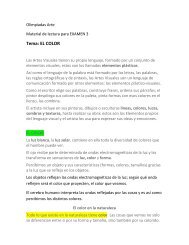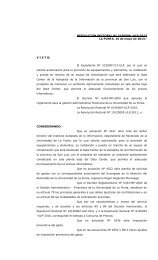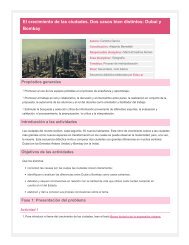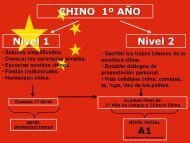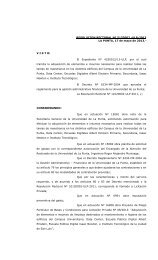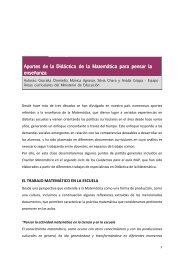e-Book PDF - Universidad de La Punta (ULP)
e-Book PDF - Universidad de La Punta (ULP)
e-Book PDF - Universidad de La Punta (ULP)
You also want an ePaper? Increase the reach of your titles
YUMPU automatically turns print PDFs into web optimized ePapers that Google loves.
<strong>de</strong> viajar por el enlace restante.<br />
En cada nodo se instalaron los<br />
equipos <strong>de</strong> transmisión necesarios<br />
para establecer cada enlace y<br />
un equipo <strong>de</strong> conmutación y ruteo<br />
<strong>de</strong> paquetes que permite elegir la<br />
mejor ruta <strong>de</strong> <strong>de</strong>stino disponible<br />
en cada momento.<br />
Los equipos <strong>de</strong> conmutación y ruteo<br />
utilizados son <strong>de</strong>l tipo switch<br />
layer 3, estos son los encargados<br />
<strong>de</strong> direccionar los paquetes hacia<br />
el <strong>de</strong>stino solicitado, ya sea en<br />
capa 2, a través <strong>de</strong> los encabezados<br />
<strong>de</strong> frame Ethernet o en capa 3,<br />
a través <strong>de</strong> los encabezados IP (ver<br />
figura 18).<br />
Estos equipos también realizan el<br />
encolado <strong>de</strong> los buffer <strong>de</strong> salida y<br />
son los encargados <strong>de</strong> aplicar las<br />
políticas <strong>de</strong> calidad <strong>de</strong> servicio.<br />
Figura 18: equipos <strong>de</strong> conmutación <strong>de</strong> paquetes: Switch layer 3 / Figure 18: Packet Switching Equipment:<br />
Switch 3-<strong>La</strong>yer<br />
Resultó necesario aplicar calidad<br />
<strong>de</strong> servicio, <strong>de</strong>bido a los diferentes<br />
tipos <strong>de</strong> tráficos que circulan<br />
por la red. Por ejemplo, el tráfico<br />
<strong>de</strong> comunicaciones <strong>de</strong> voz es <strong>de</strong>l<br />
tipo “real time” o en tiempo real, y<br />
este tráfico es muy sensible a los<br />
retardos (<strong>de</strong>lay) y a las variaciones<br />
<strong>de</strong> los retardos (jiter), por lo cual,<br />
este tráfico <strong>de</strong>be ser encolado con<br />
prioridad y <strong>de</strong> manera tal <strong>de</strong> entregar<br />
todos los paquetes en <strong>de</strong>stino<br />
con un <strong>de</strong>lay preestablecido y sin<br />
variaciones <strong>de</strong> retardo.<br />
<strong>La</strong>s políticas <strong>de</strong> calidad <strong>de</strong> servicio<br />
aplicadas en capa 3, fueron implementadas<br />
con el método conocido<br />
como DSCP, por sus siglas en ingles<br />
“Differentiated Services Co<strong>de</strong><br />
Point”. Este método se utilizó para<br />
| 41<br />
The connection of the building grounding and the rest was carried<br />
out by means of 30 by 2 mm copper strapping (fig. 15 and 16).<br />
The entire aforementioned infrastructure at each main shelter ensures<br />
optimum conditions for the storage of carrier class telecommunication<br />
equipment to guarantee an availability of proper service.<br />
For the main backbone, each shelter communicates to the next<br />
through links that conform a ring topology, whereas for the branch<br />
that serves the south of the province, the connection is star shaped,<br />
but the links are 1+1 redundant type (fig. 17).<br />
The topology that was used has the advantage that, in case one of<br />
the links is out of or<strong>de</strong>r, the connection is not lost since the information<br />
can travel through the remaining link.<br />
At each no<strong>de</strong>, the necessary transmission equipment to establish<br />
each link has been installed, as well as packet switching and routing<br />
equipment that allows choosing the best available <strong>de</strong>stination route<br />
at any given time.<br />
The switching and routing equipment is switch-layer three type; this<br />
equipment is responsible for directing the packets towards the requested<br />
<strong>de</strong>stination, whether it is on layer 2, through the heading of<br />
Ethernet frame, or on layer 3 through the IP headings (fig. 18)<br />
This equipment also performs the queuing of the outgoing buffers<br />
and it is in charge of enforcing the quality of service policies.<br />
Applying quality of service turned out to be a necessity, due to the different<br />
kinds of traffic that travel through the network. For example,<br />
voice-communication traffic is in real time, and that kind of communication<br />
is very sensitive to <strong>de</strong>lays and to variations in the <strong>de</strong>lays<br />
(jiter) and therefore this traffic must be queued with priority and in<br />
such a way that all packets are <strong>de</strong>livered with a pre-established <strong>de</strong>lay<br />
without variations.



